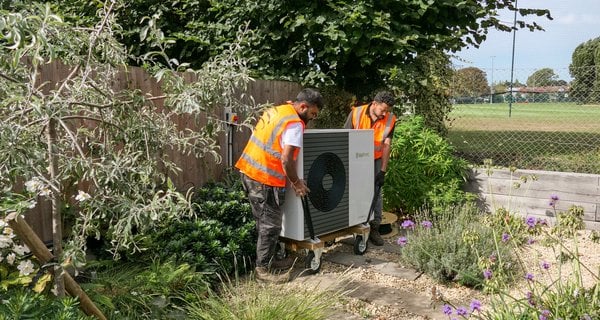Household preferences for clean heat schemes
After exploring how the idea of a clean heat neighbourhood might be introduced, we turned to what it would mean in practice. We asked participants to reflect on which parts of the process they felt should be coordinated – and where they preferred more individual control. This section of the report looks at which elements of the scheme people saw as personal choices, and where they were open to collective, coordinated approaches.
Opt-in timing: needs to fit individual circumstances
Opt-in timing was commonly seen as an individual decision, and participants wanted enough time and information to feel confident opting in. Sales pressure, decision fatigue, and the need to align with personal circumstances were all mentioned:
“Three months is not enough time. You need longer to do the research. First instinct is to say no – and then change your mind later.” “When and if depends on when I can remove my old system. If someone else won’t take it out, I can’t just say yes.”
Several participants flagged a fear of missing out vs fear of acting too soon, noting that schemes can be complex or feel rushed: “I’d want time to compare grants, compare systems. I don’t want to be pushed into it.”
Installer selection: experience and trust drive preferences
Participants were divided on installer selection, based on whether they trusted the provider. Some leaned toward wanting individual choice, often due to prior negative experiences: “The council rolled out solar panels before. The company people went with was not one we would have chosen. So we kept out of the system.”
For others, a coordinated approach was acceptable if it included quality assurance or a choice among vetted options: “Helpful if someone you could trust provided the contractors. Like: here’s a list of relevant installers for this tech – we’re trusting them to give us the best.” Others imagined hybrid models: “You can have the option of who to do it. Everyone has their own rate, their own budget, so someone might choose someone different.”
A recurring theme was the need to validate both the finance providers and the quality of installers or the specific technology setups. Many participants expressed a strong desire for reassurance through sufficient online reviews (eg, Checkatrade) or word-of-mouth recommendations: “Would want to make sure they’ve installed before – with some reviews, something like Checkatrade.”
Some were more comfortable if they could speak with a nearby friend or neighbour in similar circumstances who had used the same installer. While some trusted their council to coordinate a reliable contractor, others emphasised the importance of independently verifying quality and trustworthiness before committing.
Some recognised that coordination might make logistics smoother or cheaper, but were still cautious: “If we all have the same installer, it means we have the same tech, and that makes everything easier. But getting that agreement can be difficult.” This suggests that clean heat neighbourhoods should not exclude people from choosing their own supplier and making the switch individually, without the support of an area-based scheme.
Technology type: balancing expertise with perceived suitability
Opinions on technology choice were mixed. Some felt this was something best decided by experts, particularly if they lacked the time or knowledge to evaluate systems themselves: “I don’t feel informed enough. I wouldn’t have the time to sit and read about every type. If someone I trust – even my partner or neighbour – knows better, I’d let them choose.”
Others, especially homeowners, emphasised that technology must fit their specific property, lifestyle, or preferences: “Heat pumps are large – where you can put it really matters. I’d want to know if I can have it in a less obvious spot.” “It’s got to suit your household – your living style. Are they tailoring it to that?”
Still others felt comfortable deferring to the council or trusted experts, but only if the scheme came with a reliable contact point: “Ideally you go along with what the council recommends. But if it’s your house, you need to work with them – not just be told what to do.”
Participants also raised concerns about the visual and spatial impact of large heat pumps, and whether they would have any say over placement and design: “Acceptability depends on whether you can put it in a less conspicuous area.”
A few also raised concerns about longevity and cost-effectiveness: “It’s important to know the technology is going to be cost-effective and will last more than 5-10 years. Don’t want a repeat of when boilers first came out – you had to either change them every few years or keep paying for constant servicing.”
For others, a lack of familiarity with the range of clean heat system options was in itself off-putting. This led to suggestions that any introductory information or adverts should include simple, high-level summaries or comparisons: “Just something short – like a simple comparison of what the technologies are.”
Installation timing: the need for flexibility
Most participants leaned towards wanting individual control over when installation happens, citing personal routines, care responsibilities, or work schedules: “If someone works from home or has young children, they’ve got to factor that in.” “I’d need to know when they’re coming – I don’t want it done while we’ve got guests or I’m away.”
However, three participants placed installation timing between ‘individual’ and ‘coordinated’, suggesting they saw potential for coordination to offer practical or financial benefits – as long as some flexibility remained: “I get that the savings might be better if it’s all on the same day – but that’s not always possible.” “If it’s in the same week, maybe. But same day with everyone? That’s too much.”
Some also assumed that coordination might require all installations to happen at once – raising concerns about feasibility: “Do you also need to talk to your neighbours (and coordinate) when to install? Is it the same day? I’d need to know more.”
In addition to timing, participants highlighted the importance of personal agency during installation: “Don’t touch or work on this wall or room and so on.”
Financing options: a personal decision
Across nearly all interviews, financing was seen as a personal element. Seven participants placed it squarely on the individual side, citing how financial circumstances vary widely between households, making standardised or coordinated finance options feel impractical:
“A blanket finance plan won’t work for everyone. Everyone’s income is totally different. Everyone’s life stage is different – someone could be on maternity leave, someone else just had a big windfall.” “You might want to pay over two years; I might want to pay upfront. That’s not something you can coordinate.”
Participants expressed a strong desire for flexibility, including payment timelines and grant availability. Trust was also critical, particularly in relation to any third-party finance or lenders: “You’d want to make sure the people you might borrow from are trustworthy.”
Two participants placed this element between individual and coordinated, acknowledging that coordination could sometimes help enable access to finance or group savings, but only if individual control remained. Still, for most, finance was the top priority to control: “Finance – that’s the biggest part.”
Grants were seen as not just helpful, but necessary, both to motivate opt-ins and to avoid leaving some households behind: “If the grant covers everything, then I’d let them do it all, but I still want to see if there are other options.”
Some participants also raised concerns about being left behind without the right financial support. One quote captured the multiple layers of concern: “Have you got the money? Or if you haven’t, is there another suitable way to do it economically? And are the people you might borrow from trustworthy?”
Street improvements and coordination: collective by nature, but must be communicated
All participants, except for one who said that both of these elements are “unimportant” to them and thus left them aside, expressed that street improvements and street works coordination were inherently coordinated. However, they wanted these efforts to be clearly communicated, well managed, and respectful of local logistics (eg, parking, schools, emergency services):
“If you close the road for four weeks, people aren’t going to be happy. Might have to start commuting at 4:00am instead of 7:00am.” “You’ve got to tell people what’s going on. Like, how many vehicles will be on the street? Will the fire services still get through?” “We’ve got a school across the street, starting work before 9:00am would be a disaster.”
Participants raised concerns about how large numbers of contractor or installer vehicles could create major disruptions, especially in areas with limited parking or narrow access. Several participants also linked coordination quality to trust, noting that even if they weren’t involved in decision-making, they needed to be kept informed. Others expressed concern that street works might not clearly relate to the clean heat neighbourhood scheme at all or to enabling ‘clean heating’, and should be presented in a way that makes the connection to the scheme obvious. There was also an appetite for consultation and co-design, especially if street changes could improve the area: “It would be nice to get ideas from people who live on the street. Some streets don’t need much, but others could really benefit.”
Table of individual vs coordinated choice for clean heat neighbourhood schemes
Other key insights
Beyond the specific elements people placed on the individual–coordinated spectrum, we heard broader reflections on what enables trust, how much agency people are willing to trade off and under what conditions, and what kind of community coordination feels realistic. This section captures those wider insights, along with key considerations for anyone designing future clean heat neighbourhood schemes.
On agency trade-off: flexible with strong incentives
A few participants said they would accept reduced choice over design, technology, or installer if specific conditions were met, especially where financial savings or trusted assurances were present. This was most often mentioned in relation to: group-based savings (eg, collective installation discounts), grants that covered full or majority costs, confidence that a neighbour with a similar home had already tested the setup, and perceived guarantees under a council-backed scheme:
“If the grant covers everything, then I’d let them do it all – but I still want to see if there are other options.” “If someone else on my street has it and it’s working, then I’d probably go with that.”
On community coordination: expected, but few wanted to lead it
Some participants imagined that neighbours or the wider community would play a role in shaping scheme choices, like selecting technologies or coordinating installations. This expectation was often linked to a desire for local, street-level leadership.
“It should be a community decision, or at least have a few people on the street to help coordinate things.”
But only three participants said they’d be willing to take on that kind of role. Two said they’d act as a street leader or scheme liaison only if: there were two to three others sharing the role, or the group was small (around 20 households), or the tasks and expectations were clearly defined: “I wouldn’t do it alone. If it was two or three of us, sure – we could share the load.”
While informal leadership may emerge in some streets, schemes should not assume this will happen organically – and may need to support it more formally if community input is desired.





